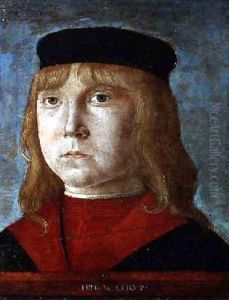Girolamo Mocetto Paintings
Girolamo Mocetto was an Italian Renaissance painter, engraver, and stained glass designer who was born in 1450 in Murano, a series of islands in the Venetian Lagoon known for its glass making. Little is known about Mocetto's early life, but it is believed that he was initially trained in the Venetian workshop of the painter Gentile Bellini. Mocetto's work shows a strong influence of the Bellini family and the Venetian school of painting, characterized by its rich color and detailed narrative.
Mocetto is perhaps best known for his work as an engraver. His engravings demonstrate a high level of skill and are noted for their complexity and the use of chiaroscuro, a technique that plays with light and shadow to give depth to an image. Mocetto's prints often depict religious themes, mythology, and occasionally portraits, reflecting common subjects of the Italian Renaissance. His engravings were widely disseminated and would have been accessible to a broad audience, contributing to the spread of Renaissance styles and ideas.
As a painter, Mocetto's works include altarpieces and frescoes, many of which have been lost or are known to us only through written descriptions. His style as a painter was eclectic, borrowing elements from his contemporaries and combining them to create his own distinct approach. He was also involved in the design of stained glass windows, a less common occupation at the time, which reflects his connection to Murano and its glassmaking tradition.
Despite his contributions to Renaissance art, Mocetto did not achieve the same level of fame as some of his contemporaries, and as a result, his works were sometimes mistakenly attributed to more well-known artists. This has led to challenges in fully reconstructing his oeuvre. Mocetto continued to work until his death in 1531 in Venice. Today, his surviving prints and the few extant paintings contribute valuable insight into the Venetian Renaissance and the period's artistic exchanges.
